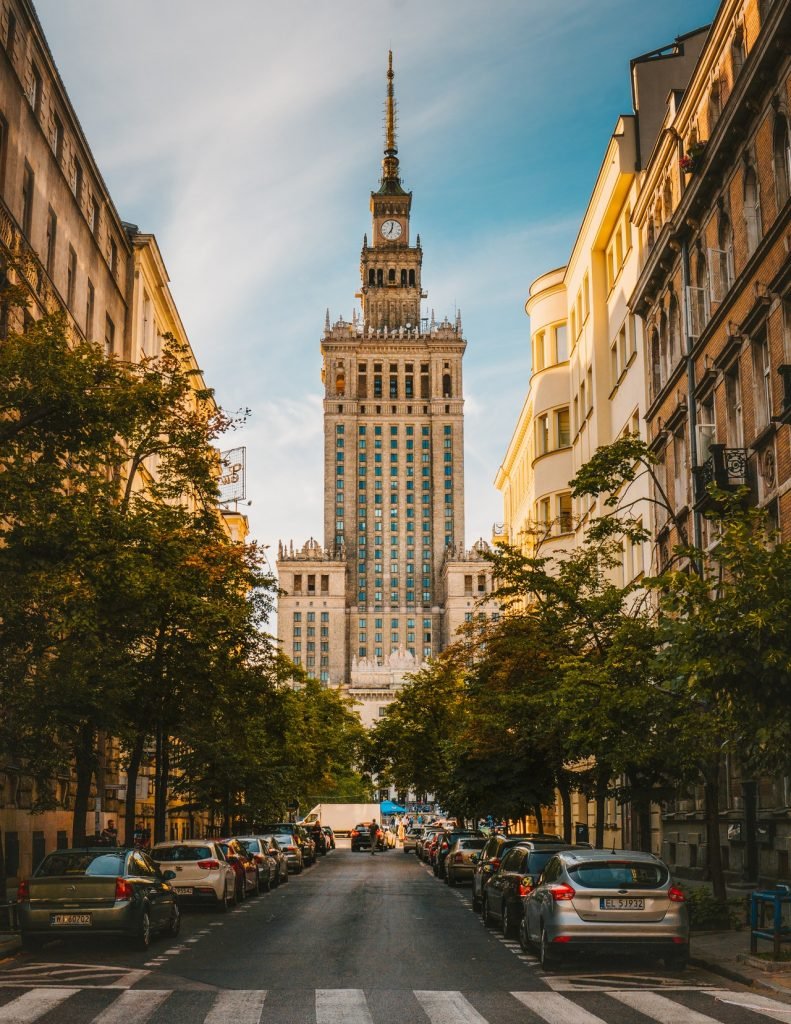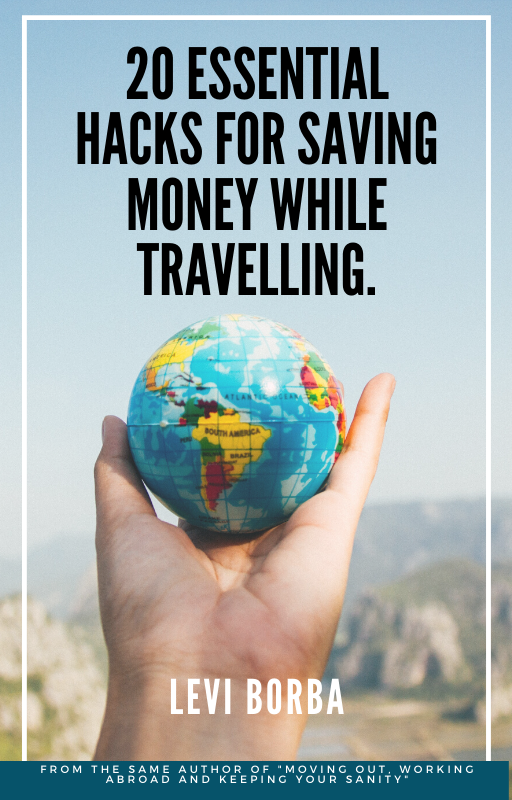What if you could buy farmland in Europe for less than most people pay for coffee in a year?
It sounds impossible
But…
I’m about to break the biggest myth about European land ownership.
Because I found 10 places where non-EU citizens can legally buy a farm for less than a used Honda civic (and I actually live near one of them).
I am not talking about war zone, or extremely poor places.
No… I am talking about sunny Mediterranean countries where people live beyond 100 years old
Or Scandinavia, with all its benefits
The three cheapest spots on my list? They’re in two of the world’s wealthiest nations, with wonderful quality of life, yet their agricultural land costs less than in Wyoming.
Ready to explore these game-changing opportunities with me?
The Cheapest Places to Buy Farmland in Europe
10: Nord-Vest, Romania
Our first stop is Nord-Vest Romania, where $2,647 per acre gets you some of Europe’s best farm land. This region sits in northwest Romania, next to Hungary and Serbia. Cluj-Napoca is its major city – a tech hub that links old farming with modern shipping.
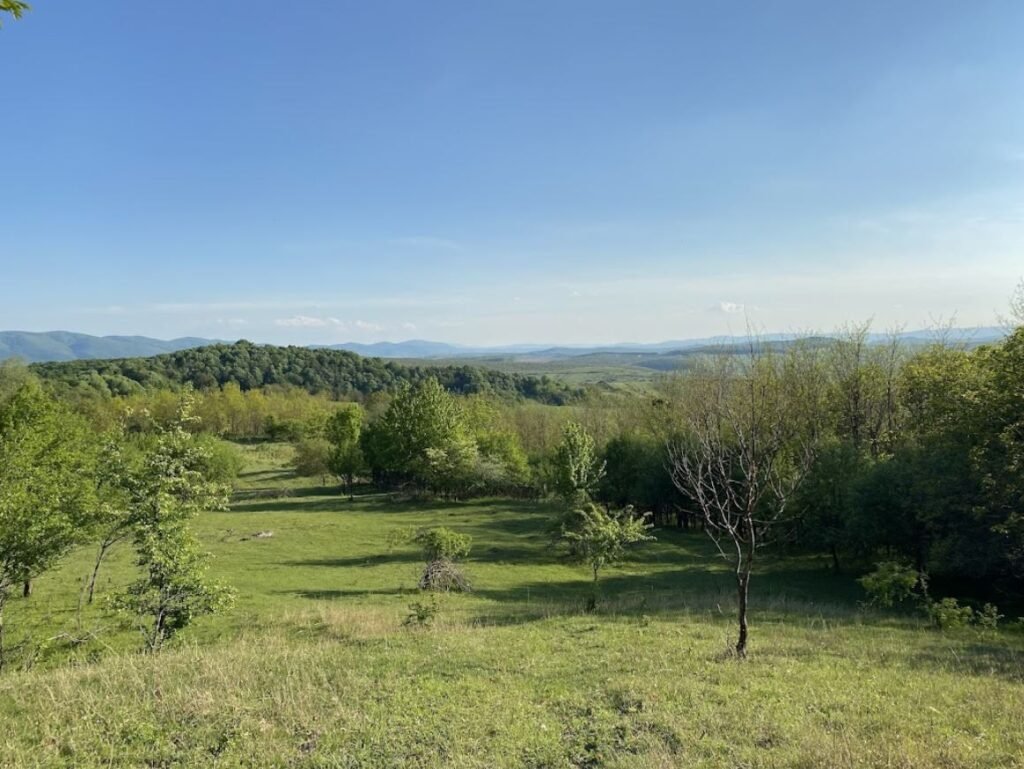
But here’s what scares most foreign buyers: the red tape. Romania hits you with pre-buy rights for co-owners and neighbors who can block your deals. Then you must start a Romanian company just to follow local rules. Most buyers see this mess and leave.

That’s why this chance exists. Nord-Vest grows many crops. Wheat and corn lead grain production. The rich soils grow potatoes, vegetables, and fruit. The climate brings warm summers at 24.5°C and 840mm of rain yearly – perfect for diverse farming. Small family farms raise cattle, pigs, and sheep.

Here’s where smart buyers turn red tape into profit. When you start that Romanian company, you get EU help worth €16.6 billion through 2023-2027. Young farmers can grab up to €70,000 in extra help. The government adds tax breaks and direct grants for new projects.

The location creates real advantages. You sit between Western European markets and cheap resources. Romania offers tax breaks in free trade zones. EU membership removes trade blocks with your biggest customers.

The payoff is big.
So… what if I told you our next spot offers direct foreign ownership without the Romanian company rules?

See, this map shows current laws for foreign land ownership in Europe. In some countries it’s very hard to buy land, or even banned. What’s the point of saying Belarus land is cheap if foreigners can’t buy there? Even in some EU countries it’s very hard for foreigners to buy farmland.
Take my example: I live in Europe for 8 years and married a Polish citizen for 5 years — still, it’s illegal for me to buy farmland in Poland since I’m Non-EU!
So in this ranking you are reading, nearly all countries are blue or green on this map.
Now, the next country just recently removed most of their restrictions on non-EU expats buying land.
8 and 9: Pannonian Croatia & North Croatia
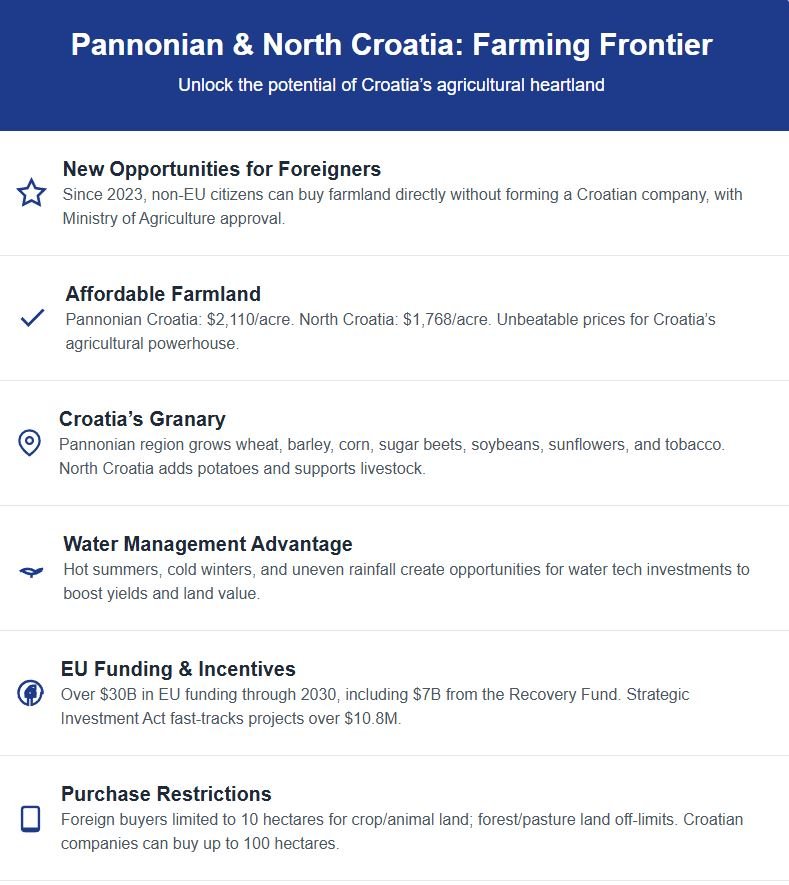
Here, everything changed for foreign buyers in 2023 – Croatia removed its blocks on direct farm land buys for non-EU citizens. You can now buy Croatian farmland without starting a local company first.
Pannonian region sits in eastern Croatia near Hungarian and Serbian borders, with Osijek as its main city. North Croatia runs along the northern border with Slovenia and Hungary, centered around Zagreb. These regions offer farmland at $2110 and $1768 per acre – prices that seem too good to be true.
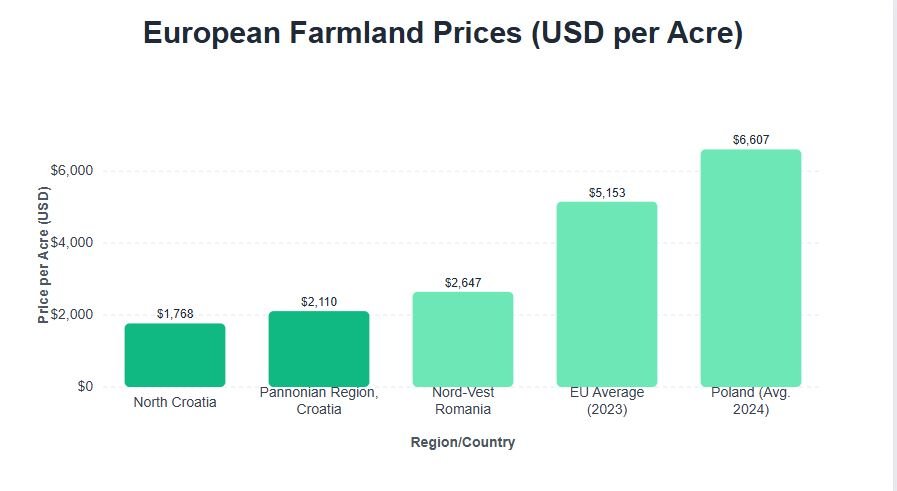
Think about this. You’re looking at regions known as Croatia’s farm powerhouse. Pannonian area grows massive amounts of wheat, barley, and corn across rich plains. Sugar beets, soybeans, sunflowers, and tobacco also grow well here. North Croatia focuses on similar crops plus potatoes. Both regions keep livestock for local animal breeds.
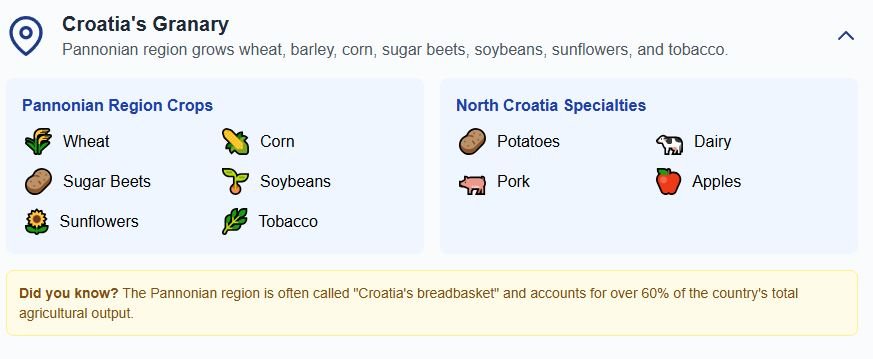
Here’s what makes these cheap prices so surprising. Pannonian region earned its name as Croatia’s “granary” through decades of good farming. The climate brings hot summers and cold winters with uneven rain. This creates both problems and chances.
The need for water becomes your key advantage. Dry periods and uneven rainfall mean most winning operations need good water systems. Smart buyers see this creates huge potential for infrastructure growth. You’re not just buying land – you’re buying into a region where water tech investments can boost output and land values.
Croatia’s EU membership opens real funding chances. The country gets over $30 billion in EU funding through 2030, including $7 billion from the Recovery Fund. The government gives money incentives for foreign buyers. The Strategic Investment Act speeds up red tape for projects worth $10.8 million or more.
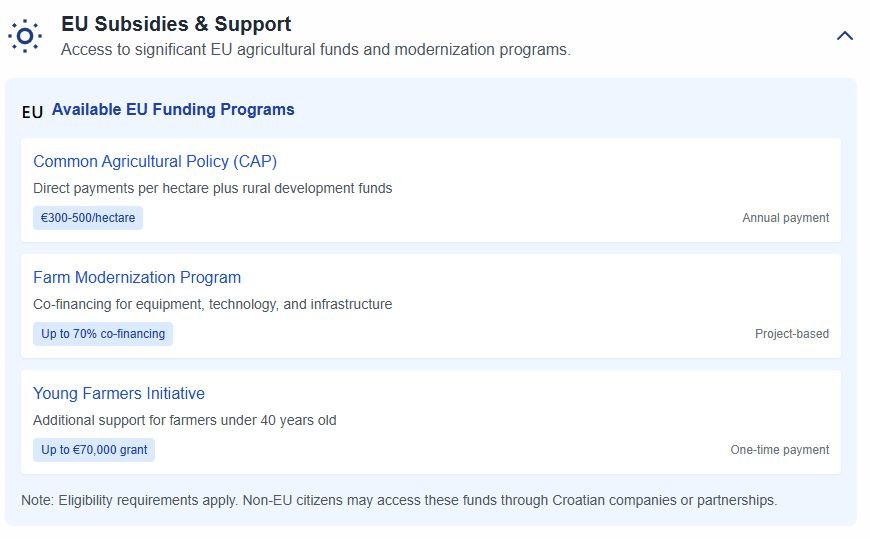
But wait – blocks still exist. Foreign buyers can only buy land marked for crop growing and animal raising. Forest and pasture land stay off-limits. Private persons face a 10-hectare max. Croatian companies can get up to 100 hectares. Foreign companies not registered in Croatia hit the same 10-hectare ceiling.
The recent policy change means you can now directly own Croatian farmland, but timing and location matter. Ministry of Agriculture approval stays required for all foreign buys.
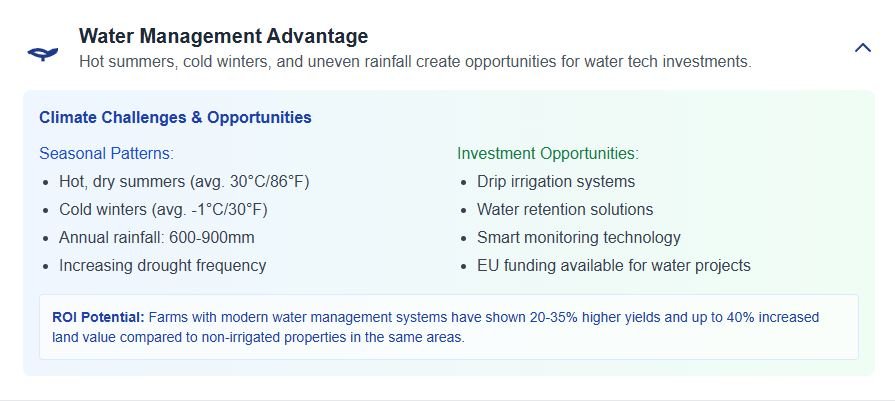
The next place is in one of the most developed in Europe, and one of the best wine-producers in the world.
But before I reveal it, I have some really good news.
FREE FOR A LIMITED TIME: Grab your Expat Wealth & Lifestyle Compass ($108 value) today! Includes our 74-page guide of Affordable European Cities, our Zero-Tax countries report, and our expat checklist. https://bit.ly/ExpatWealthLifestyleCompass Join us here before this offer ends.
7: Bourgogne-Franche-Comté, France
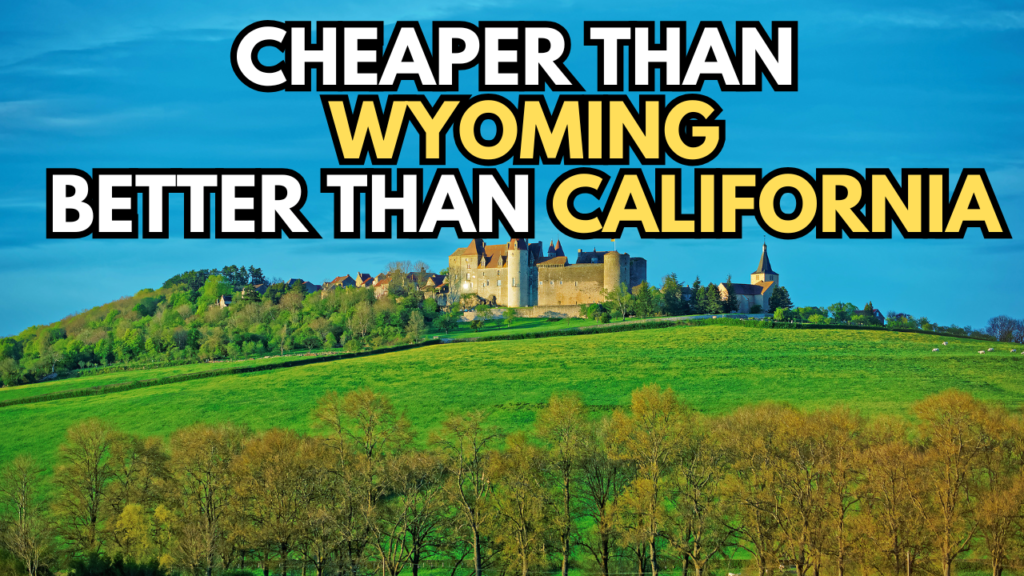
While everyone talks about Bordeaux and Champagne, there’s a French region making world-class wines and cheeses at farmland prices that would shock Paris buyers. Bourgogne-Franche-Comté sits in eastern France, stretching from Burgundy’s famous vineyards to the Swiss border, with Dijon as its major city.

Bourgogne-Franche-Comté offers some of France’s lowest farmland prices at $1,339 per acre for empty land and $1,261 per acre for rented plots. The area excels at winter wheat growing across its rich plains. Special wine growing makes top wines. Charolais beef cattle graze the region’s pastures. Traditional dairy operations create premium cheeses that get high prices in European markets.
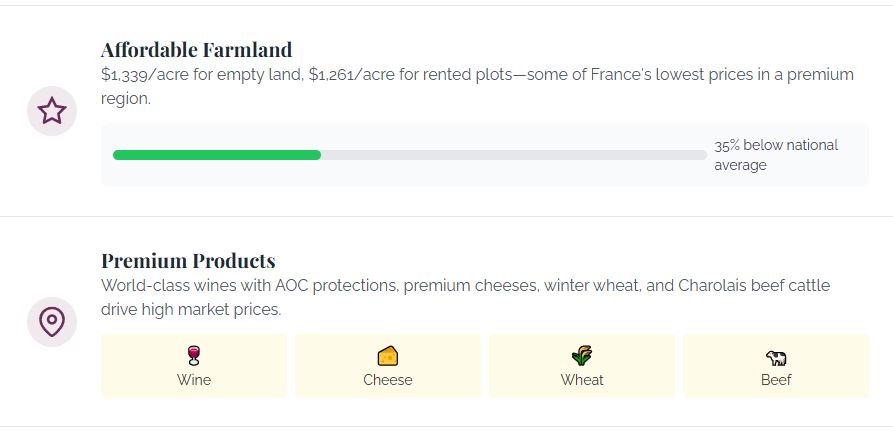
This is what an expat living in Franche-Comté told us:
“As a Canadian, for me Franche-Comté ressembles Ontario, but housing is a fraction of the cost. The food is better. Everything is closer together, so you don’t have to drive for hours to go do something interesting or fun. And the climate is perrrfect.”
But then, things get complex. SAFER holds pre-buy rights that can block foreign buys entirely. When you sign a deal for farm land, SAFER can step in and buy that same property at market value, blocking your buy. This government agency exists to group farmland for local economic benefit, and they use this right regularly. The process extends your timeline by 2.5 to 3 months between signing and closing, adding doubt to every deal.
The region’s focus creates real value opportunities. Wine operations benefit from AOC protections that guarantee premium pricing for traditional wine types. Local cheese producers get higher margins through protected naming systems. Organic farming efforts get government support.

France set aside €100 billion through the “France Relance” program, with €40 billion coming from EU funds. The plan dedicates €30 billion for ecological transition projects in agriculture. The agrifood industry gets strategic investment priority. The Investments for the Future Programme supports innovation in responsible agriculture and food sovereignty efforts. These funding streams open big chances for qualifying buyers.
Foreign buyers must get approval from the local Prefect before completing farm buys. This approval process requires showing long-term commitment to local farm development rather than short-term speculation.
The value proposition centers on premium products that get high prices in special markets. Traditional winemaking methods and distinctive terroir create products that sell for multiples of commodity crop prices. Investment strategies focusing on quality over quantity can generate big returns despite lower production volumes. The regulatory hurdles actually protect market entry, limiting competition and preserving premium pricing structures.
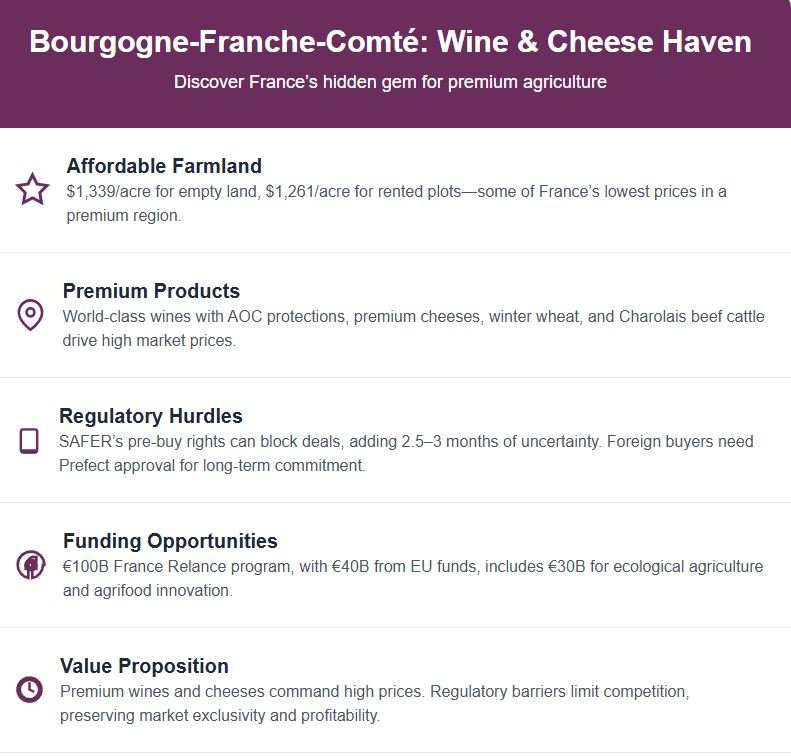
France is a very specific country – some people love it, others, not so much. I wrote an article explaining the challenges of living in France – things most people underestimate.
Now let me show you countries where ownership structures operate much more simply, without the complex red tape systems that define French agriculture.
6. Vidzeme and Latgale, Latvia
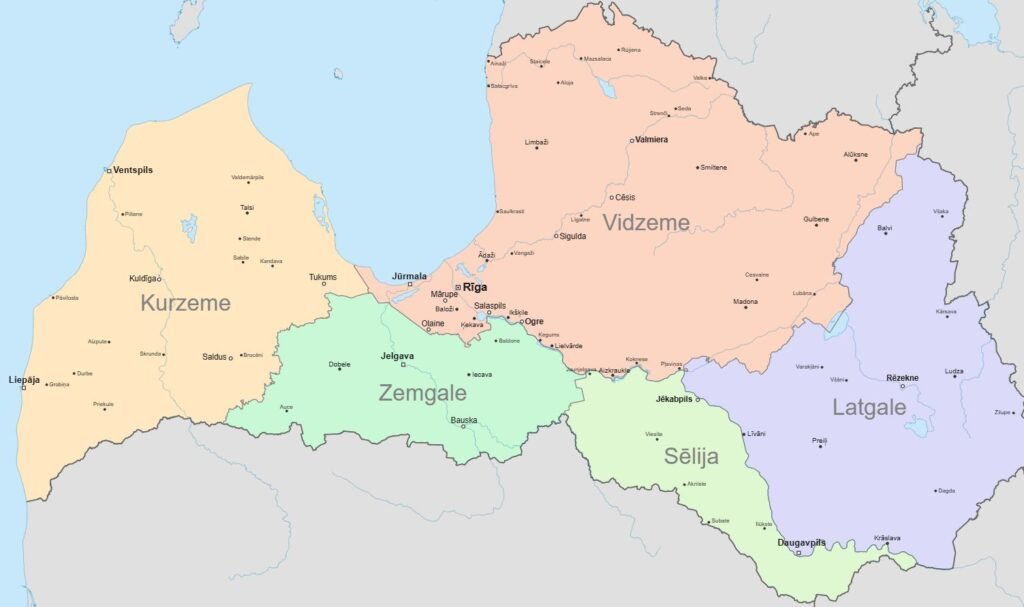
Latvia’s biggest farm problem is also its greatest chance for expats wanting farmland. The Vidzeme region stretches across northern Latvia with Valmiera as its main city. Latgale covers the southeastern corner with Daugavpils as its center. Both regions offer farmland around $2,099 per acre. Latgale prices drop as low as $1,095 per acre while Vidzeme can exceed $2,282 per acre.

These regions focus on grain crops, with rye leading production followed by wheat, oats, and barley. Farmers also grow potatoes, onions, carrots, and sugar beets for export markets. Local livestock includes the Latvian Blue Cow, Latvijas Ardenis, Latvijas Baltā, Latvian Brown cow, and Latvian local goat breeds that adapt well to the Baltic climate.

Here’s the challenge that creates opportunity. Over 40% of Latvian farm soils need liming to fix acidity problems. Another 35% have too little phosphorus. 24% show low potassium content. This soil damage stems from too little farmer investment in fertility and widespread single-crop growing practices. Most buyers see these numbers and run away from what looks like expensive soil repair projects.
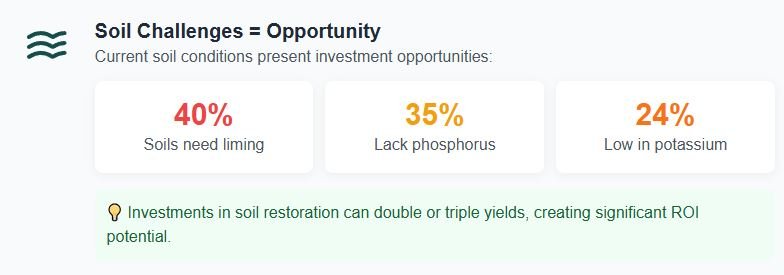
Latvia actively encourages foreign direct investment through the Latvian Investment and Development Agency, which offers full services to future buyers. The government provides grants, money incentives, VAT waivers, and tax rebates for companies operating in Latvia’s five Special Economic Zones. These zones include two free ports that create additional advantages for farm exporters.
Municipal permission requirements add complexity to land buys, especially for plots with houses. Foreign buyers need working knowledge of the Latvian language to buy farm land directly. You can acquire ownership through a Latvian-registered company, but more than 50% must be owned by Latvian citizens or entities from countries with bilateral investment treaties with Latvia.
Soil improvement investments can dramatically increase land productivity and value. Proper liming treatments restore soil pH balance. Phosphorus and potassium supplementation rebuilds fertility. These improvements often double or triple crop yields within three to five years. Farm land deals increased 25% in 2024, with a 39% rise in sold land area, showing growing market confidence.
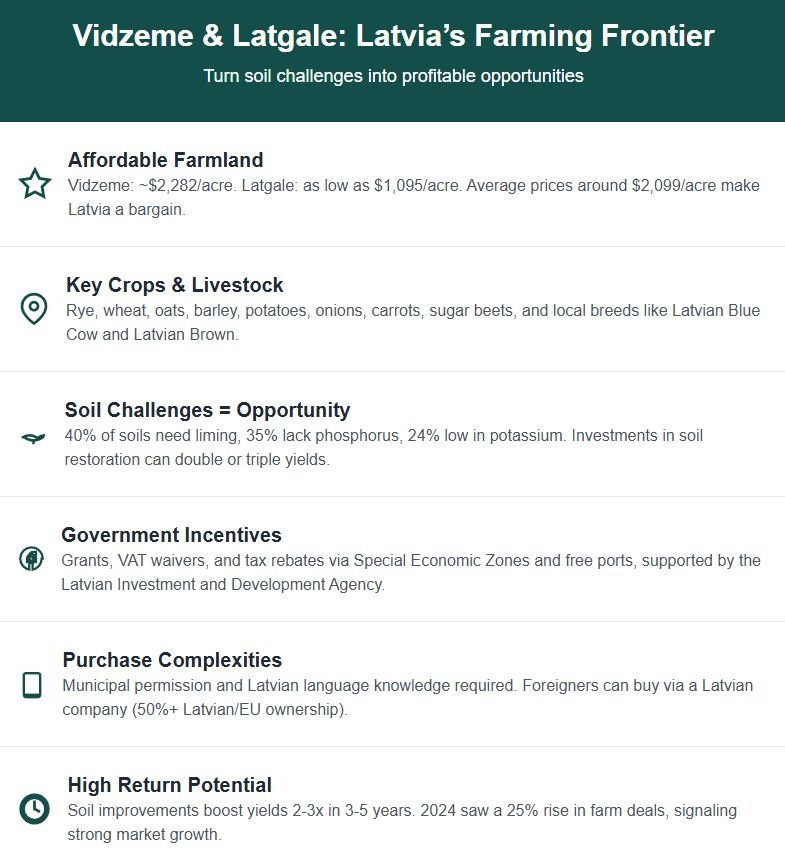
Government incentives target farm modernization through various funding programs. Smart buyers who tackle soil improvement transform damaged land into highly productive farm assets that generate big returns.
5. Lääne County and Hiiumaa, Estonia

In the world’s most digitally advanced country, buying farmland is as streamlined as ordering coffee online. Lääne County sits on Estonia’s western coast with Haapsalu as its main city. Hiiumaa represents Estonia’s second-largest island in the Baltic Sea with Kärdla as its center.
Both regions offer below-EU-average farmland prices that make them attractive for budget-conscious buyers. Depending on the productivity of the land, prices per acre can be as low as US$1329.

These areas specialize in temporary grasslands, cereals including wheat, barley, oats, and rye, plus oilseeds such as rapeseed. Farmers also grow potatoes and various vegetables across the fertile plains. Livestock farming thrives here with milk cattle, pigs, and poultry operations providing diverse farm opportunities throughout both regions.

Estonia’s highly digitalized economy and business-friendly environment currently make deals incredibly smooth. The government actively seeks large-scale foreign investments, offering big incentives and reimbursement programs to attract capital. EU membership provides access to regional funds and a stable economic framework that enhances appeal for world buyers.

Current blocks limit farm and forest land buys to 10 hectares for most buyers. Foreign companies buying over 10 hectares must demonstrate continuous engagement in agriculture or forest management for more than three years. Private individuals from outside EU require municipal permission, and at least six months of permanent residency in Estonia. A complete ban exists for third-country citizens on small islands or municipalities bordering the Russian Federation.

The regions focus heavily on temporary grasslands and livestock farming because of lower soil fertility and smaller land plot sizes. These factors impact farm productivity and may limit crop choices while requiring higher input costs to achieve desired yields. Estonian farm land demonstrated remarkable value growth, with median hectare prices increasing by 757% between 2004 and 2018.
4. Yugozapaden, Bulgaria

The Yugozapaden region sits in southwestern Bulgaria, bordering Greece, North Macedonia, and Serbia, with Sofia as its major city and economic center.
This region produces cereals including wheat, barley, and corn across fertile valleys. The Blagoevgrad district dedicates big farm area to extensive grazing for livestock operations. Greenhouse farming thrives here due to favorable climate and soil conditions. Permanent pastures average $1131 per acre according to 2023 data.

Yugozapaden Bulgaria offers favorable farm climate and strong cereal crop potential across diverse terrain. The region benefits from Mediterranean influences that create longer growing seasons and reliable precipitation patterns. Soil quality supports both intensive cultivation and extensive livestock operations.

And here is what creates the unusual opportunity – deals in this area are described as “nearly nonexistent.” The farmland market shows severe lack of activity, meaning selling land in the future could prove difficult and tie up capital for extended periods. Recent price declines range from under 10% to as much as 20% in some areas during 2024.
Just like in Romania, in Bulgaria Foreigners must establish a local entity in Bulgaria to buy real estate.

Land prices continue declining while economic uncertainties persist. Falling grain and oilseed prices combine with broader geopolitical instability to create volatile market conditions. The average rent for land in Southern Bulgaria reaches approximately $114 per acre, reflecting current market pressures.
Foreign buyers cite corruption, red tape hurdles, and inefficient judicial systems as major barriers. The unpredictable regulatory framework makes getting necessary permits difficult and expensive.

Farm land also suffers from damage issues including erosion, acidification, and salinization. These problems require costly repair efforts that impact overall profitability. Even low initial prices may not reflect true investment costs.

Market lack of liquidity creates opportunity for buyers who understand the risks and can wait for market recovery. Bulgaria receives approximately $5.7 billion in EU recovery funds through 2026, targeting development projects that could benefit agriculture indirectly.
3. Mellersta Norrland, Sweden

In one of the world’s wealthiest countries, you can buy farmland for less than most people spend on a vacation – if you don’t mind the weather. Mellersta Norrland sits in north-central Sweden, covering part of the vast Norrland terrain that stretches across 60% of Sweden’s landmass but houses only 12% of its population. Sundsvall serves as the main city in this sparsely populated region dominated by forests, lakes, and mountains.

Mellersta Norrland Sweden offers farmland at $1090 per acre, focusing on grass leys, cereals, and dairy farming operations. Grass leys make up 77% of arable land in northern counties, primarily using red clover, timothy, and meadow fescue for silage and hay production. Farmers also grow barley and oats as the main cereals, while potatoes perform surprisingly well despite challenging conditions.

Now, the secret that makes these low prices so striking. Sweden maintains some of the world’s highest living standards, yet farm land costs remain remarkably cheap. The mild subarctic climate creates short, mild summers and long, severe winters that severely limit crop variety and productivity. Early autumn frosts pose recurring risks that further shorten the effective growing period.

The farm sector faces big structural changes, with decreasing farm numbers and a rapidly aging farm population. Limited young people entering farming creates long-term challenges for labor availability and farm succession. Average farm sizes remain small at around 11 acres, while cold winters drive up building costs for livestock facilities and feed storage.
Integrated forestry opportunities add big value beyond traditional farming. Winter becomes “forestry time” for farmers, providing crucial supplementary income when farm activities cease. Vast forest tracts offer diversified returns through logging and timber operations that complement farm production throughout the year.

High production costs require special national aid programs to maintain farm viability. The Swedish government offers incentives for businesses in economically depressed areas, while EU Common Agricultural Policy direct support payments provide significant positive impact on farm prices.

The harsh climate that limits crop diversity also eliminates many farm problems, creating unique advantages through natural pest control benefits of extreme cold temperatures.
Now let’s go to the absolute top 2 cheapest places to buy farmland in Europe:
2. Sud Jura, France

I will start this one with a shocker: You can own vineyards in the same region that produces some of France’s most exclusive wines, at prices that seem too good to be true. Sud Jura sits in eastern France within the Bourgogne-Franche-Comté region, with Lons-le-Saunier as its main city. This area represents one of France’s most undervalued farm opportunities.

Sud Jura France offers farmland at $907 per acre — values might be a bit higher for more productive soils, but it is still accessible for expats seeking good farm assets.

The region produces prestigious viticulture including Chardonnay, which makes up 48% of grape production, and Pinot Noir at 11%. These familiar varieties command high prices in global markets while benefiting from French wine prestige.
Beyond wine grapes, Sud Jura supports dairy farming operations that produce celebrated cheeses like Comté, Morbier, and Mont-d’or. Cattle farming thrives across the region’s diverse terrain. Winter wheat cultivation also performs well here, taking advantage of fertile soils and favorable growing conditions.

Let’s talk about what makes these low land prices so surprising.
Sud Jura produces some of France’s most exclusive wines, including Vin Jaune, which commands premium prices in special markets. The region contributes less than 1% to national wine production volume, creating scarcity that drives up value. Robust appellation systems including AOC for wines and AOP for cheeses protect product quality, origin, and traditional production methods.
The region specializes in unique varieties that exist nowhere else. Savagnin grapes make up 17% of production and thrive on blue calcareous clay soils with high iron content. Poulsard represents 18% of plantings and requires specific red or blue clay conditions. Trousseau accounts for 5% of production and flourishes on well-exposed sedimentary soils with good drainage.

Dairy farming opportunities create additional revenue streams through premium cheese production. Comté cheese benefits from AOP protection that guarantees market stability and premium pricing. The region’s commitment to preserving traditional farming practices contributes to its unique cultural identity.
SAFER red tape adds complexity through legal rights of first refusal on farm land sales. This government agency can buy land at market value, potentially blocking foreign buys. Viticulture and traditional cheese production demand specific expertise, continuous maintenance, and big investment in specialized equipment. These high specialization requirements limit competition from casual buyers.

The scenic landscape, rich food heritage, and unique wine culture make Sud Jura highly attractive for agritourism and farm-stay experiences. Visitors pay premium prices to experience distinctive winemaking methods and traditional farming practices. This creates diversified revenue streams beyond primary farm production.
The combination of premium wine production and protected designations creates sustainable high-value agriculture that justifies navigating French regulatory complexity. AOC and AOP labels protect market position while unique terroir ensures product differentiation.

However… What happens when you move to regions where extreme climate conditions create entirely different farm challenges and opportunities?
1 – The cheapest place to buy farmland in Europe: Övre Norrland, Sweden
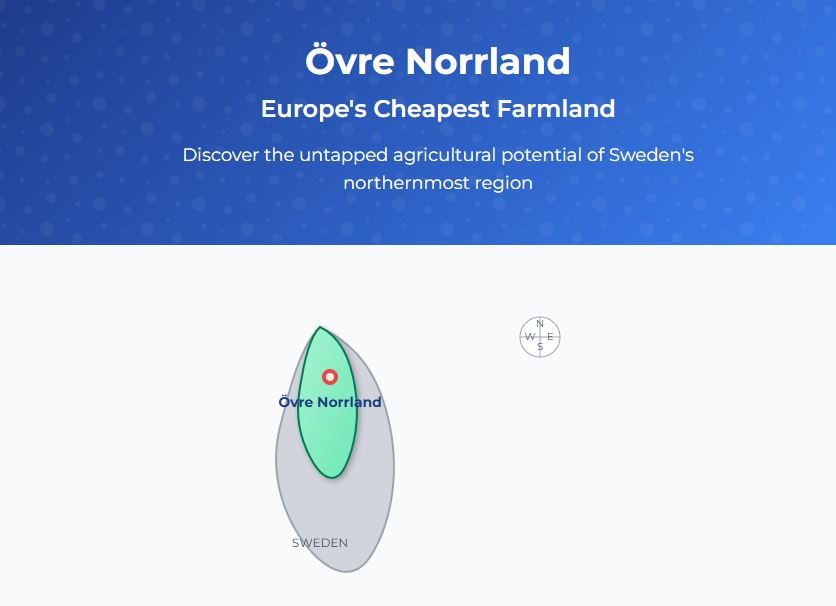
At $895 per acre, this is officially the cheapest farmland in Europe where non-EU citizens can buy – but it comes with the continent’s most extreme farming conditions. Övre Norrland stretches across Sweden’s northernmost region, covering vast areas above the Arctic Circle with Umeå as its main city. This remote territory represents the absolute bottom of European farmland prices.

Agriculture here focuses on hay and potatoes as staple crops, with barley and oats grown primarily for animal feed. Grass leys dominate the landscape, using red clover and timothy for silage and hay production. Dairy farming operates as the largest farm sector economically, while cattle raising provides essential livestock operations.

The extreme short growing season restricts farm possibilities dramatically. The effective growing period can shrink to just 120 days, with early autumn frosts threatening even hardy crops like winter wheat, barley, and rye. Traditional grains, beets, and oilseeds simply cannot survive these conditions. Many northern areas find forestry more economically viable than agriculture.

The harsh conditions naturally limit the spread of plant diseases and pests, potentially reducing chemical input needs and lowering operational costs. Extreme cold temperatures provide natural pest control benefits that eliminate many farm problems plaguing warmer regions.

Forestry integration opportunities create crucial income diversification. Winter becomes productive forestry time when farm activities cease, providing supplementary revenue through timber production. This dual approach often proves necessary since farm income alone rarely achieves economic viability.

The aging farm population and high operational costs for livestock present ongoing challenges. Big investments in robust buildings for feed storage and heating become essential. Remote rural locations create social isolation and limit access to services.
For buyers who can handle the climate challenges, this represents the ultimate European farmland value with built-in natural advantages. The combination of rock-bottom prices and unique environmental benefits creates opportunities unavailable anywhere else on the continent.
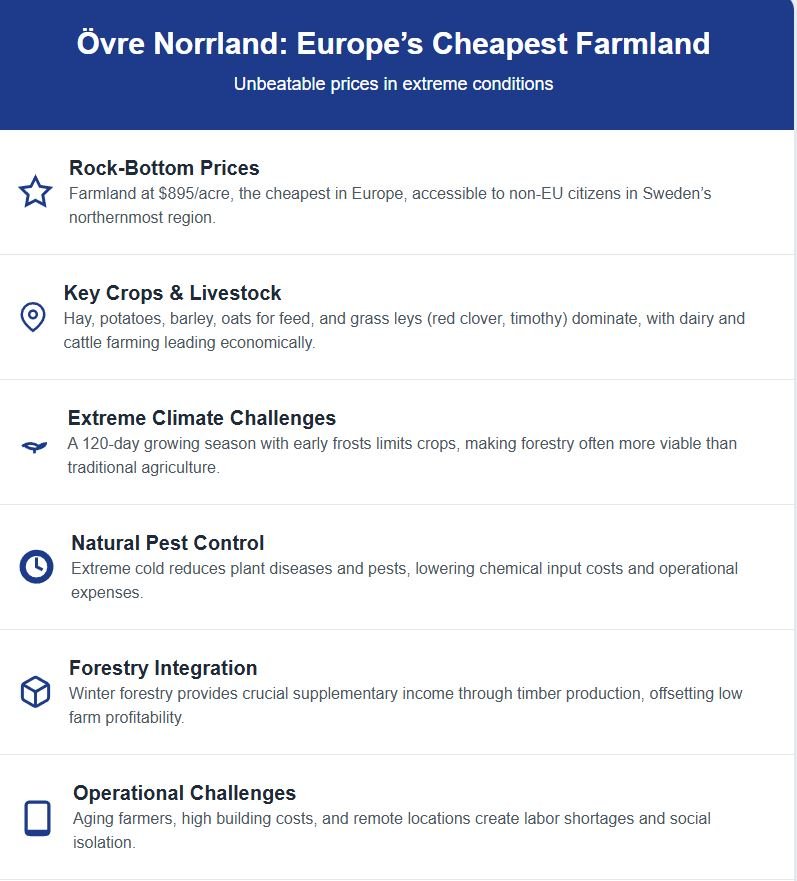
But what if instead of a rural life, you would prefer the small town life, in a Mediterranean country, with kind neighbors, sunshine, and a beach nearby?
It was thinking about you that I compiled my MOST IMPORTANT video ever, where I selected the best cities to move to in Europe – it is by far our greatest video, and you can watch it below.
Levi Borba is the founder of expatriateconsultancy.com, creator of the channel The Expat, and best-selling author. You can find him on X here. Some of the links above might be affiliated links, meaning the author earns a small commission if you make a purchase.

